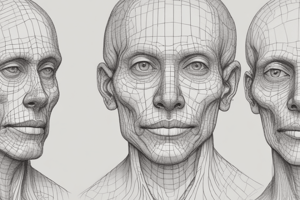Podcast
Questions and Answers
Which bone forms the roof of the nasal cavities and contains olfactory foramina?
Which bone forms the roof of the nasal cavities and contains olfactory foramina?
- Frontal bone
- Temporal bone
- Cribriform plate of the ethmoid bone (correct)
- Parietal bone
Which bone contains the optic foramen transmitting CNII (vision)?
Which bone contains the optic foramen transmitting CNII (vision)?
- Occipital bone
- Temporal bone
- Frontal bone
- Sphenoid bone (correct)
Which bone forms the lateral bridge of the nose and connects the frontal and nasal bones?
Which bone forms the lateral bridge of the nose and connects the frontal and nasal bones?
- Zygomatic bone
- Palatine bone
- Temporal bone
- Frontal processes of the maxilla bone (correct)
Which bone connects with the zygomatic bones through its zygomatic processes?
Which bone connects with the zygomatic bones through its zygomatic processes?
What is the function of the tarsal glands in the eyelids?
What is the function of the tarsal glands in the eyelids?
Which muscle is responsible for elevating the upper eyelid?
Which muscle is responsible for elevating the upper eyelid?
What is the function of the orbicularis oculi muscle?
What is the function of the orbicularis oculi muscle?
What is the purpose of convergence in vision?
What is the purpose of convergence in vision?
Which bone in the body does not articulate with another bone?
Which bone in the body does not articulate with another bone?
Where is the larynx located?
Where is the larynx located?
Which phase of swallowing involves the elevation of the larynx and epiglottis to block the trachea?
Which phase of swallowing involves the elevation of the larynx and epiglottis to block the trachea?
Which joint is the most active joint in the human body?
Which joint is the most active joint in the human body?
Which muscle depresses the mandible to open the mouth?
Which muscle depresses the mandible to open the mouth?
Which muscle is necessary for chewing and swallowing?
Which muscle is necessary for chewing and swallowing?
Which muscle is innervated by CNVIII and serves to tense the skin of the neck?
Which muscle is innervated by CNVIII and serves to tense the skin of the neck?
What is the function of the orbit?
What is the function of the orbit?
Which layer of the globe includes the choroid, ciliary body, and iris?
Which layer of the globe includes the choroid, ciliary body, and iris?
What controls the size of the pupil?
What controls the size of the pupil?
What involves the contraction of the extraocular muscles?
What involves the contraction of the extraocular muscles?
Which cranial nerves innervate the extraocular muscles?
Which cranial nerves innervate the extraocular muscles?
What is the function of the nose?
What is the function of the nose?
Which nerve supplies the external nose?
Which nerve supplies the external nose?
What is the function of paranasal sinuses?
What is the function of paranasal sinuses?
What is the role of the olfactory nerves (CNI)?
What is the role of the olfactory nerves (CNI)?
Which part of the ear is responsible for equilibrium?
Which part of the ear is responsible for equilibrium?
What is the function of the middle ear?
What is the function of the middle ear?
Which nerve innervates the lips and mouth?
Which nerve innervates the lips and mouth?
What is the function of the infraorbital foramen?
What is the function of the infraorbital foramen?
What does the alveolar margin contain?
What does the alveolar margin contain?
What divides the nasal cavities?
What divides the nasal cavities?
What is the auricle a part of?
What is the auricle a part of?
What is the role of the tympanic membrane?
What is the role of the tympanic membrane?
Flashcards are hidden until you start studying
Study Notes
Anatomy of the Face, Ear, and Mouth
- The inferior orbital fissure is an opening within each orbit formed by the maxillae and sphenoid bone.
- The infraorbital foramen is an opening under each orbit for the passage of infraorbital nerves and vessels.
- The alveolar margin is the oral margin of the maxillae that contains the upper teeth.
- The nose includes the external nose and nasal cavity and functions in smell, humidification, respiration, filtration, reception, and eliminating secretions through paranasal sinuses and nasolacrimal ducts.
- The external nose consists of cartilage and skin, with nerve supply from the trigeminal nerve (CNV1).
- The nasal cavities are divided by the nasal septum and lined with mucous membrane, featuring three projecting conchae (turbinates) for air cleansing and temperature control.
- Paranasal sinuses, including the ethmoid, sphenoid, frontal, and maxillary sinuses, lighten the weight of the skull and are palpable during physical exams.
- Olfaction involves the olfactory epithelium, olfactory nerves (CNI), bulbs, and tract, contributing to the sense of smell in the cerebrum.
- The ear is responsible for hearing and equilibrium and comprises the external, middle, and inner parts.
- The external ear consists of the auricle, external acoustic meatus, and tympanic membrane, while the middle ear amplifies sound and includes the auditory ossicles and the pharyngotympanic (Eustachian) tube for pressure equalization.
- The inner ear consists of the bony and membranous labyrinths, serving acoustic and vestibular functions for equilibrium.
- The lips and mouth are controlled by a series of muscles, with the oral cavity lined with mucous membrane and featuring openings for salivary gland ducts, innervated by the trigeminal nerve (CN V).
Studying That Suits You
Use AI to generate personalized quizzes and flashcards to suit your learning preferences.




